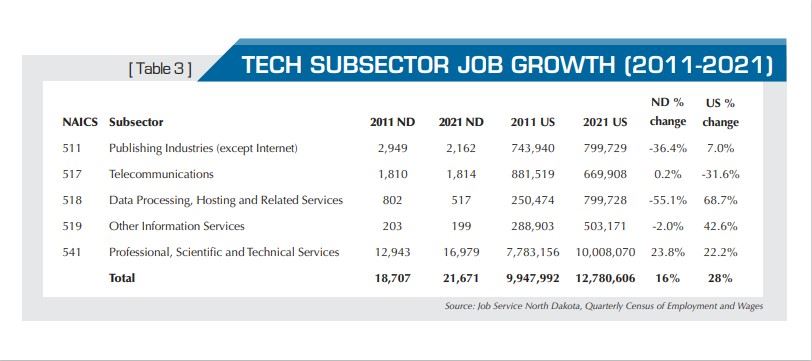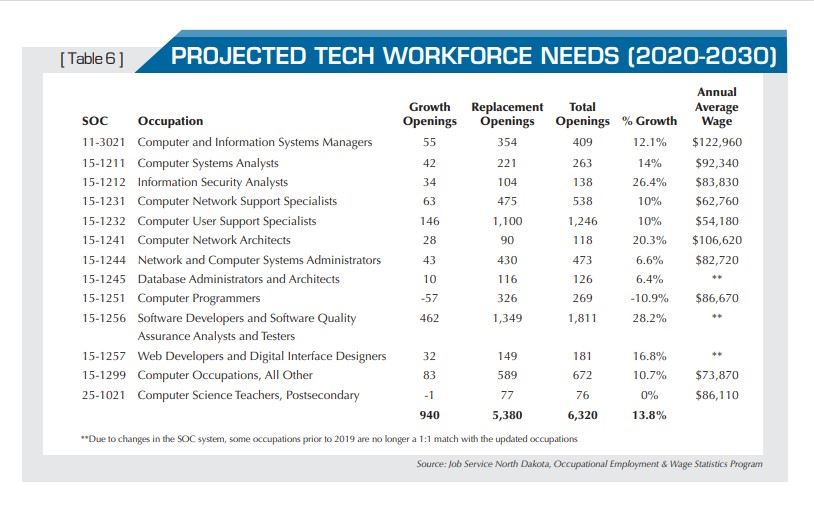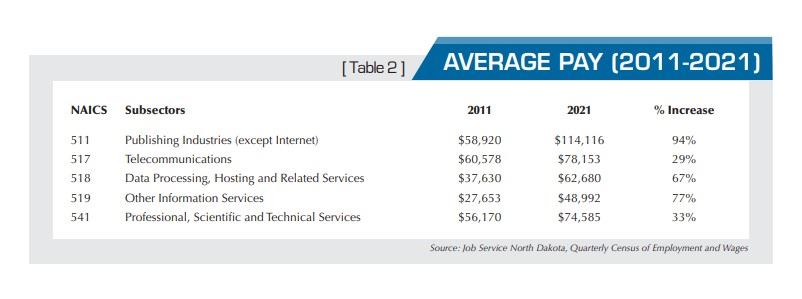Statistics
The diversity of the state’s technology industry contributes significantly to the overall growth and economic strength of North Dakota. More than 4,110 businesses within the tech subsectors employ 21,671 North Dakotans in various fields including technology, human relations, finance, and marketing.
The tech industry generates tax revenue for both local and state governments, and agriculture, health care, energy, manufacturing, and financial services are all impacted by technology, which plays a key role in enhancing the productivity and growth of these and many other industries.
The impact of technology on the state is outlined in three critical elements:
• Tech businesses are knowledge-based and create a significant number of high-paying jobs.
• The tech industry is categorized as a primary sector, meaning it brings outside dollars into the state.
• Tech industries on average generate higher-added value per worker than non-tech industries.
Gross Domestic Product Contributions
Gross domestic product (GDP) is defined as the total market value of all goods and services produced within a state and is on the measures of income and output for the state’s economy. It is considered the sum of the value added at every state of production. Over the past decade, the contribution of the technology subsectors to the state’s GDP grew 39%. The tech subsectors are responsible for 6% of the state’s 2020 total GDP of $52.02 billion, with contributions of more than $3 billion.
Technology Subsector Job Growth
On average, employment in the state’s and nation’s tech subsectors has continued to experience growth. North Dakota’s growth was on par with that of the nation with a 16% increase in employment in North Dakota’s tech subsectors in the last decade and a 28% increase in the nation’s tech subsector employment (Table 3). North Dakota’s growth was in the professional, scientific and technical service subsector while the remaining subsectors declined.
Projected Technology Workforce Needs
Over the next 10 years, North Dakota is estimated to need more than 6,320 new and replacement technology positions. Growth in the industry will create the need for 940 employees to fill new positions. The remaining positions will be replacements.The state’s technology industry currently employs 7,010 North Dakotans, and this projected growth means replacement combined with new positions will equal about 86% of the state’s current technology workforce. Software developers and software quality assurance analysts and testers are the technology occupations with the highest percentage of projected growth (28.2%). Information security analysts (26.4%) and computer network architects (20.3%) are the technology occupations with the second and third highest percentage of projected growth.
Through 2030, the three technology occupations projected to have the largest number of openings include software developers and software quality assurance analysts and testers with 1,811 openings; computer user support specialists with 1,246 projected openings; and computer network support specialists with 538 openings (Table 6).

Pay Contributed to the Economy
The average pay for those employed in the technology subsector has increased 57% over the past decade (Table 2). In 2021, the average annual wage for tech occupations was $74,585, which is 42% higher than the average annual wage for all occupations in North Dakota.
